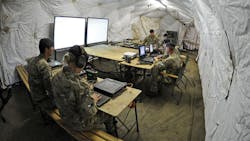Air Force eyes secure networking for shared situational awareness in SATCOM-denied environments
ROME, N.Y. — U.S. Air Force researchers are kicking off a potential half-billion-dollar program to develop secure networking for battlefield data that intelligently distributes information for shared situational awareness and timely decision-making.
Officials of the Air Force Research Laboratory’s Information Directorate in Rome, N.Y., issued a broad agency announcement in December (FA875019S7001) for the Timely, Secure, and Mission-Responsive Aerial Warfighting Network Capabilities program to develop a mission-responsive network to translate sensory data into actionable information.
The network enables commanders to control lines of communication from the command post to the contested tactical edge, and bring together platforms, sensors, and shooters to respond to evolving military situations in today’s information-dominated environment, Air Force researchers explain.
Industry is considering new secure networking for battlefield data that intelligently distributes information for shared situational awareness and timely decision-making.
Military forces today, however, cannot rely on a data-neutral network; they need an affordable, extensible, interoperable communications architecture that intelligently shares situational awareness, researchers say.
For now, the Air Force wants three-to-five-page white papers on experimental computer hardware and software development; ways to validate with model-based systems; and demonstrations of experimental computer hardware and antennas that might lead to such an intelligent tactical network, and help the Air Force solve some of today’s aerial network connectivity problems.
Researchers particularly are interested in agile, resilient, affordable, and IP-capable battlefield networking that uses alternative positioning, navigation and timing (PNT); agile communication links and networks; and tactical network security.
Alternative PNT battlefield networking involves using existing technologies to operate effectively in areas where satellite communications (SATCOM) and Global Positioning System (GPS) satellite navigation are unavailable.
Agile communication links and networks involves developing reliable wideband connectivity for secure, low-probability-of-intercept, and anti-jam multi-mission radio for line-of-sight and beyond-line-of-site communications.
Tactical network security involves sharing voice, video, and text files at several levels of classification. Securing information is by data inspection and other techniques to prevent data spills and cyber attacks.
Air Force officials say they may spend as much on this project as $500 million through 2023: $105.5 million each year from 2019 through 2021, $100.5 million in 2022, and $83 million in 2023. Several contractors will be involved in the program, and the typical award will be for between $250,000 and $100 million.
Companies interested should email unclassified white papers no later than 18 Jan. 2019 to the Air Force’s Howard Beyer at [email protected]. Send classified white papers by post or by courier to AFRL/RITE, 525 Brooks Road, Rome NY 13441-4505. Those submitting promising white papers will be asked to submit formal proposals.
For questions or concerns contact Howard Beyer by email at [email protected], or by phone at 315-330-4718. Also contact Amber Buckley by email at [email protected], or by phone at 315-330-3605.
More information is online at https://www.fbo.gov/spg/USAF/AFMC/AFRLRRS/FA875019S7001/listing.html.

